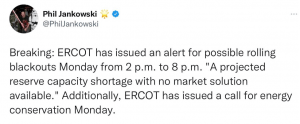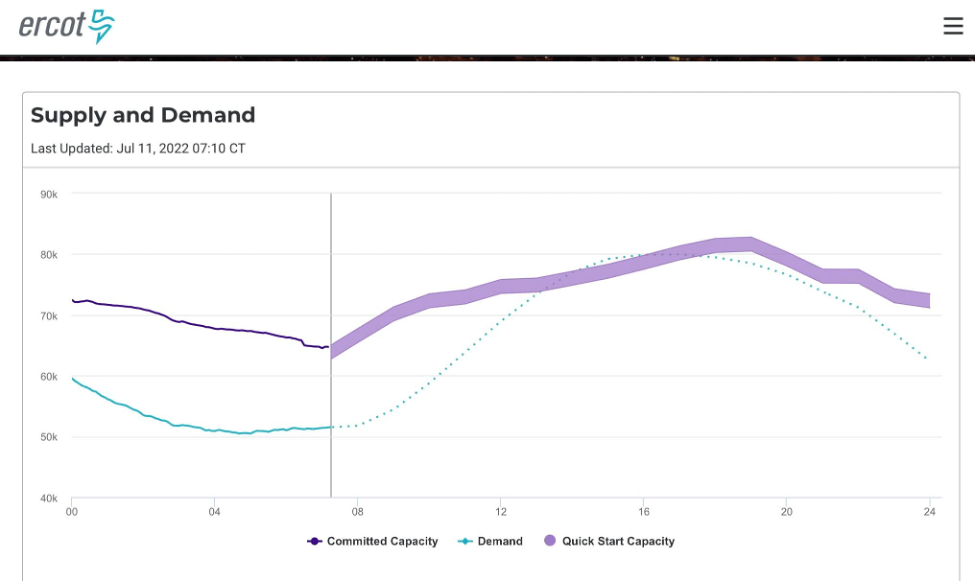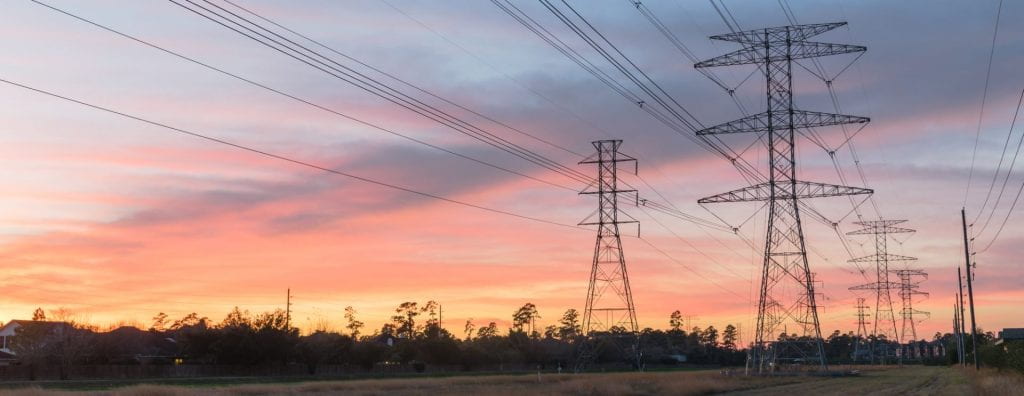 As I sipped coffee and poked through the news early Monday morning, I saw the warning from the Electric Reliability Council of Texas (ERCOT): prepare for rolling blackouts. It wasn’t unexpected. Temperatures have been breaking records left and right across Texas, with Austin’s Camp Mabry sizzling in at 110 °F the day before, beating a record set in 1917 by 5 °F, and San Antonio searing in at 106 °F, beating a previous record by 3 °F set in 2020. Similar temperatures are expected today, but as a working weekday, electricity consumption is generally higher, so—with everything else being the same—there’s more demand on the grid. Not only that, ERCOT projects that Texas (as of this moment) will break an all-time record for energy use, a record we have broken over and over this year.
As I sipped coffee and poked through the news early Monday morning, I saw the warning from the Electric Reliability Council of Texas (ERCOT): prepare for rolling blackouts. It wasn’t unexpected. Temperatures have been breaking records left and right across Texas, with Austin’s Camp Mabry sizzling in at 110 °F the day before, beating a record set in 1917 by 5 °F, and San Antonio searing in at 106 °F, beating a previous record by 3 °F set in 2020. Similar temperatures are expected today, but as a working weekday, electricity consumption is generally higher, so—with everything else being the same—there’s more demand on the grid. Not only that, ERCOT projects that Texas (as of this moment) will break an all-time record for energy use, a record we have broken over and over this year.

So why don’t we have enough power?
A lot has been said about Texas’ market-based solution to electricity generation and having, for the most part, its own grid. I’m not an expert on market-based solutions and grids, but I can’t help but wonder if any market-based solution is fundamentally doomed from the start if the state doesn’t consider climate change in its planning exercises.
Similar to water planning, power planning involves estimating maximum demand under a growing population. Traditionally, the climatic playing field for energy use is defined through historical information: from the coldest temperature on record to the hottest temperature on record. And Texas is following this tradition. But with climate change, planning for the record means you are always running behind because the next broken record is just around the next month.
We are always being “surprised” by hotter-than-normal temperatures and weather extremes when we shouldn’t be. This is the new abnormal. And more of it is coming. Isn’t this what we should be planning for instead of what happened last year or over the record? As Texas Tech’s Katherine Hayhoe has noted, we are driving into the future based solely on what’s in the rearview mirror. That’s fine if the road ahead is straight, but it’s a serious problem if the road is veering to the left as temperatures are as we ascend the temperature-with-time plot.
Unlike water, where drought takes months to years to threaten water supplies, electricity is being challenged moment by moment by seasonally warm and cold spells and summer and winter records. A misstep in projecting electricity consumption and generation is felt almost instantly. As we all know, the consequences of those missteps can be catastrophic.
Water-resource planners may feel smug hiding behind their surface and subsurface reservoirs, but water planners should note what is happening to the grid, a microcosm of time portending greater issues in future decades. For water, Texas is similarly planning for the past when the future (including today) looks quite different. Rolling dryouts would be considered a devastating failure in the water world, but some communities flirted with a complete dryout during the 2011 to 2015 drought. Unlike the energy world, the water world has forced conservation under the implementation of drought contingency plans. But like the energy world, when impending disaster looms over the day, it’s too late to build infrastructure to solve the problem.
Regardless of similarities and differences, both power planners and water planners need to consider that the world of the future, including the near future, will be much different than the world of the past. Days like today, weeks like Winter Storm Uri, and droughts like 2011 through 2015 are reminders that we need to learn and do better. But we’ve missed the point if we only plan for days like today, Winter Storm Uri, and droughts like 2011 through 2015. The resiliency of our power and water resources depends on planning for the future we will see, not the past we have seen.

With abundant sun and scarce water, thermal and photovoltaic power generation for the future sounds like a winning generation if we look ahead and not in the rear-view mirror.
One interesting aspect of the current drought (THE HEAT DOME) is that it is suppressing winds, which is causing less wind-generated power than expected. But then again, we should expect these situations. Storage will be key with wind and solar.
Let’s propose our guidance on the matter. Intersection with the future is how I express it. Anticipating the consequences and messaging an alarm is beneficial if there is a proposed solution that perpetrates the discussion.
Yes! Here at the Meadows Center we are working to provide the climate information that decisionmakers and citizens need to make informed decisions on future water resources. We are helped, in large part, by distributed supplies led by numerous folks. Power, on the other hand, has this central control via ERCOT. Perhaps better statistical tools for ERCOT would help?